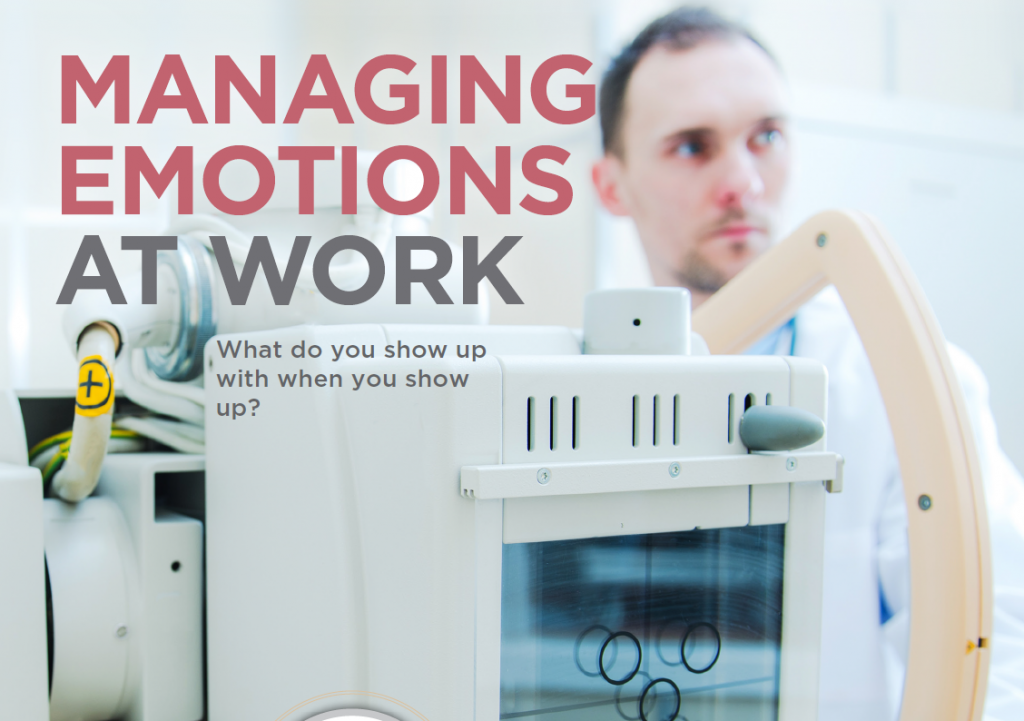 Working in the medical imaging space is stressful. On the client side, patient satisfaction is critical to reimbursement; on the management side, so is patient throughput. The success of either is rooted in technical responsibilities like budgeting, personnel, schedule management and device uptime, all of which require tight controls and are subject to ever-shifting institutional priorities. What happens to those high-stakes conditions when other stressors from personal life find their way into the picture?
Working in the medical imaging space is stressful. On the client side, patient satisfaction is critical to reimbursement; on the management side, so is patient throughput. The success of either is rooted in technical responsibilities like budgeting, personnel, schedule management and device uptime, all of which require tight controls and are subject to ever-shifting institutional priorities. What happens to those high-stakes conditions when other stressors from personal life find their way into the picture?
Jim Fedele, director of biomedical engineering at UPMC Susquehanna in Williamsport, Pennsylvania has spent 30 years managing the multitude of demands that go along with overseeing the people, processes and medical devices that power a 24-hour regional emergency hospital. In that time, he’s had to cool off many a frustrated colleague, especially as the health system has consolidated. Susquehanna Health was formed from the merger of Williamsport Regional Medical Center and two other hospitals in 1994; in 2016, those facilities were integrated into the University of Pittsburgh Medical Center. Along the way, responsibilities shifted, management handed down changes from the top, and, unsurprisingly, people weren’t always excited about them.
“Once the honeymoon phase wears off, and they have to start following the rules of the big corporation, they’re resistant to the change,” Fedele said. “They like to use my guys as punching bags or for venting their feelings. Once we start telling them, ‘Hey, you can’t have this device here,’ all the rules that go along with having a good, safe equipment management plan, now they start beating up on my guys.”
Fedele’s strategy is typically to throw cold water on the situation, but even he confesses he’ll have days in which he’ll “write 30 emails about something to someone and delete all of them.”
“My mantra is practicing the pause,” Fedele said. “No good comes from shooting out an emotional response in that minute. Nobody wins if we escalate this bad behavior.”
Communication, or the lack thereof, always “is the spark that lights the fire,” Fedele said. “The smoldering issues of who’s in control, now it’s not your baby, and having this corporation watching everything you do, that’s behind the scenes … and then insert us.”
There are always stressors in a small hospital, Fedele said, from managing diverse and competing interests to dealing with dysfunction and disconnected support systems. When he’s working to get folks back online and operating at normal, a key piece of that is doing his best to not aggravate the concerns that have already been raised.
“Everybody wants to come in and do a good job,” he said. “If you’re all here for the same purpose, everyone has a job to do, we’re all on the same team. If someone’s feeling frustration, I try to acknowledge that frustration and see if there’s something we can do to help them.”
Managers like Fedele, who can navigate some of the thornier aspects of interpersonal dynamics with some aplomb and a decent amount of even-handedness, aren’t the norm in any workplace, said Christine Pearson, professor of management-global business at the Arizona State University Thunderbird School of Global Management. A researcher on organizational crisis management and dysfunctional behavior in organizations, Pearson has found that as many as 20 percent of employees may never have worked under a manager who could handle negative emotions – anger, fear and sadness – in the workplace.
“We know that those emotions come into play for us as human beings, even as we fulfill our jobs,” Pearson said. “Some of them actually brew within the workplace.When they’re ignored or stifled, they can cause a great deal of cost to the organization. It manifests in employee behaviors.”
Whether in response to a personal circumstance or one that originates in or is aggravated by the workplace, when employees feel they’re treated badly, they respond with anger, fear or sadness, Pearson said. If so, workers won’t stay late, come in early or pitch in with responsibilities unrelated to their jobs to help a colleague.
“There’s a continuum, and where the organization and the individuals in it believe they’re supposed to rate on that continuum along the way,” she said. “Problems arise when there’s a belief or a mandate that people aren’t to bring their emotions into the workplace, or to experience negative emotions in the workplace.”
“Human beings have negative feelings, and some of them start and grow stronger because of things happening outside the workplace,” Pearson said. “Some of them happen because of work, and some of them are fanned by the way that executives manage negative emotions. In research we’ve done regarding incivility, it’s astounding how few employees have had a boss who addressed it.”
Maybe the biggest hurdle to addressing workplace emotions is a decades-old norm that feelings are impermissible in the office setting, Pearson said. (Anger is “the most acceptable negative emotion in the workplace; sadness is on the other end of that continuum,” she noted.) Professionalism has been defined in many workplace cultures to exclude bringing into work the effects of whatever’s going on at home, “and if something upsets you in the workplace, you suck it up,” Pearson said. But once that thinking becomes entrenched for as long as it has been, it breeds managers that can’t respond otherwise – because they’ve never been led any differently themselves.
“Because there’s a historical trend there, it’s very likely that people who were not able to rise to the need did not have role models who could rise to the need,” Pearson said. “It starts with the leaders. What have been the experiences they’ve had, and what are the repercussions that they’re aware of, and what were the potential repercussions that they could not have been aware of?”
The first step for leaders is to “look in the mirror,” Pearson said. Without first acknowledging that emotions are real and can’t be turned off in the workplace, they can’t reach the next realization: that the messages they communicate to staff throughout their organizations can be as much of a motivating force for dealing with emotional issues that affect operations.
“You can’t rationalize around the fact that we all have negative emotions,” Pearson said. “Coordination of work among employees and clients and patients; to think you’re going to keep negative emotions out of there is ludicrous. To get the leaders in the organization to see, ‘Where am I in all this? What could it be costing us?’ – it’s not an easy change.”
“Things missed at their earliest time are cheapest do deal with,” Pearson said. “If employees get a really strong message from above that you should not be bringing anything into work that is emotionally tied, the idea that that is barred from the workplace actually causes people to still bring it. “
Pearson suggests that managers learn some basics around how to handle negative emotions without attempting amateur psychology. Rather, she suggests making personal contact with people, acknowledging their struggles and trying to bring resources to bear on the circumstance as necessary. Those vary depending upon the concerns identified, but all originate with an internal audit of how individuals have learned to manage their own behaviors.
“If you understand, you can see how someone else is going through negative emotions,” Pearson said. “Do you shy away from it because you don’t know how to work on it? Get in touch with how you relate to negative emotions, what blocks you and helps you, and what have you experienced that works – those issues spill out in terms of how you think about managing negative emotions now.”
After coming from a foundational perspective of “respecting everyone,” Pearson offered some shorthand tips for dealing with the three primary negative emotions: anger, fear and sadness. When an employee is afraid, “don’t get sucked into their anger,” she said.
“In many workplaces, that alone would make a tremendous difference,” Pearson said.
When people are afraid, she recommends that managers “do something to get them moving forward,” which may mean setting them up for success with small, manageable tasks before thrusting something more challenging upon them. And in dealing with sadness, she suggests the best thing to do is to “connect people to their natural resources.”
“If they need to work a few less hours or try to take some time off, try to connect them to their own support systems,” she said. “Try to avoid stepping into the role of coach or psychoanalyst.”
Many such concerns can be evaluated during the hiring stage, too. Pearson recommends that managers try to get a sense of what prospective employees are like as human beings by using team interviews and input from existing employees before adding a new personality into the mix. She also recommends “doing really good background checks on people going into leadership positions.”
“Each of these things can have a huge impact,” Pearson said.
The best way to make headway with negative emotions, or any emotions, is not to work around them or suppress them, but to allow them to rise to the surface so they may be dealt with. Maiga Milbourne, a nine-year yoga teacher and trainer from Merchantville, New Jersey, suggests that the concept of managing emotions can undercut the usefulness of experiencing emotions, the better to comprehend the impulses that underlie them.
“A lot of us do so much managing already, and because we’re so schooled on what behavior is appropriate, we’re not even fully experiencing the emotional responses that we have,” Milbourne said. “Without the fullness of these experiences, you can’t be fully aware of who you are, and how to operate. I think some of that might be what’s behind people’s reactivity.”
In yogic traditions, humans have many different aspects of experience – physical, intellectual, emotive, intuitive – and some or many of these selves may be underdeveloped. To Milbourne, there’s an implicit cultural idea that “emotions are invalid and should be controlled so we can get to the superior intellect.” But cutting off those feelings is cutting off another intake point for useful information, she said.
“Emotions and the information that comes from emotions are useful and probably have a place for how we should function,” Milbourne said. “It’s not to say that they are the endgame, but that we should have room for them. If I have awareness about my emotional field, then it’s less likely to drive my actions, behaviors and interactions in the workplace. If I don’t afford myself the space to get aware of that, then it’s going to govern me.”
Yoga, which is frequently recommended in the health care space as a vital exercise for physical and emotional wellness, has a tradition of “naming especially the subtle things,” Milbourne said, which offers a useful approach to understanding feelings by universalizing impulses we may have understood as personally specific.
“We start to understand that most of these experiences we go through aren’t unique, so we’re able to say, ‘this is another piece of my experience, but it’s not a problem necessarily,’ ” she said. “Yoga is varied enough to encompass all of this because there’s some kind of inherent recognition that underneath we’re really diverse.”
“It’s easy to feel like other people are the problem and the world is happening to you,” Milbourne said. “Yoga would disagree. We’re all here for an experience, and so much of the experience we perceive as happening outside of ourselves is happening in the interior.”
“What would be healthy for everyone is if we had the safety and security and the time to get to baseline regulation,” she said. “A lot of us don’t even know what we’re missing to know what we’re looking for.”








